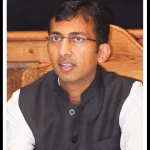Haryana has always been a land of enterprise, resilience and innovation. From its thriving industries to its sporting excellence, the state has consistently shown how vision and determination can shape destinies. Building on this spirit, the Hon’ble Chief Minister’s initiative of establishing innovative Model Sanskriti Colleges in every district is a bold step towards reimagining higher education. These institutions will not just be centres of learning but engines of innovation, employability, and entrepreneurship—aligning seamlessly with NEP 2020 and powering Haryana’s journey toward Vision 2047.
This landmark decision, envisioned by the Hon’ble Chief Minister, to establish a Model Sanskriti College (MSC) in every district headquarters represents far more than simply identifying institutions. It signals a structural transformation of higher education, aligning with NEP 2020’s vision of creating autonomous, multidisciplinary, degree-awarding colleges that combine local relevance with global competitiveness.
Conceived as a statewide platform to operationalize NEP 2020, MSCs will expand access, raise quality benchmarks and strengthen education–economy linkages. Each district will host an industry-connected hub for talent development, research translation and entrepreneurship. Strategically, MSCs advance India’s goal of achieving a 50% GER by 2035 by moving beyond identification to true transformation, through graded autonomy, flexible learning pathways and integrated work-based education that empowers both first-generation learners and working professionals within their own districts.
As on day, Haryana’s higher education system is already substantial with more than 184 government colleges, 97 aided colleges, 86 private colleges, alongside 40+ universitiesoffering a robust foundation to elevate select institutions as exemplars of excellence. Additionally, the All-India Survey on Higher Education (AISHE) 2021–22 reports that over 11 lakh students are currently enrolled in the state’s higher education ecosystem, a significant talent base that can be systematically nurtured through Model Sanskriti Colleges (MSCs) into employability, research, entrepreneurship and placement outcomes.
MSC represents a strategic roadmap to translate Haryana’s existing scale and student strength into measurable transformation, boosting GER, building quality institutionsand empowering local youths through meaningful access, autonomy and outcomes. These colleges will not only fill quantitative gaps but also catalyse regional excellence as NEP-aligned, future-ready educational hubs.
The First Phase of Model Sanskriti College (MSC) Design: From Identification to Transformation
In the first phase, the announcement of one Model Sanskriti College in every district is not the end goal—it is the beginning of a structured journey. The first phase of MSC design focuses on moving from mere identification to true transformation, where each institution evolves into a district-level hub of excellence, closely aligned and mapped with NEP 2020 pillars.
This transformation will rest on five foundational pillars:
Autonomy with Accountability
For MSCs to truly deliver, they shall enjoy graded autonomy, academic, administrativeand financial, so that they can innovate and respond to district needs without excessive delays. The graded autonomy will have its criteria’s, that state will build through a policy and institutions will have to meet those standards in order to be a MSC.At the same time, accountability mechanisms will be built in, performance will be tracked through State Governance, NAAC/NIRF accreditation cycles, student success metrics, research translationand independent third-party audits. This ensures that autonomy is not just freedom but a responsibility to demonstrate outcomes.
District Innovation & “Vocal for Local”
Each MSC shall dedicate at least 30–40% of its coursework, projects, and internships to district-specific priorities. Each district in Haryana has some uniqueness, whether that is Agri-tech and food processing in Karnal, IT, Manufacturing, logistics in Gurugram, and textiles in Panipat or renewable energy in Hisar. This approach ensures that education is not abstract, but deeply tied to local challenges and opportunities. Germany’s Universities of Applied Sciences (Fachhochschulen) and US community colleges have successfully anchored higher education in local industry needs, encouraging both employment and regional development. Haryana’s MSCs shall indigenise MSCs for its district economies under the “Vocal for Local” vision.
Employability & Global Placements
To enhance career readiness, MSCs shall embed industry-partnered programs (minimum 10%), work integrated education (wo-ed) semesters, credit-bearing apprenticeshipsand finishing schools linked to real outcomes. This aligns with the Hon’ble Chief Minister’s directive to universities to prioritize skill development and industry collaboration. Further, a Statewide Career & Mobility Network shall be created, a digital platform connecting students to domestic jobs, global placements, alumni networks and employer feedback loops. This will allow continuous updating of curricula and enable Haryana’s youth to compete both nationally and internationally.
Research that Moves the Needle
MSCs shall serve as applied research satellites to nearby state, private and central universities. Through seed grants and innovation vouchers, they shall take upreal-world problem statements from MSMEs and local industries, leading to patents, prototypes, pilots and startups. Haryana’s university system already produces strong research output (for example, several thousand Scopus-indexed publications between 2011–2020). The MSCs will extend this strength into district-level translational projects with visible economic and social impact. Funding support will be drawn from the Haryana State Research Fund, with calls aligned to district priorities and industry co-funding, ensuring faster time-to-impact.
Multidisciplinary Centres
Model Sanskriti Colleges (MSCs) shall serve as hubs of multidisciplinary learning, where students can seamlessly integrate knowledge across sciences, humanities, technology and vocational domains. By breaking the silos of traditional education, these centres will nurture holistic thinkers, problem-solvers, and innovators who can address real-world challenges with creativity and agility. This convergence of disciplines will not only enhance learning outcomes but also strengthen employability, entrepreneurial spirit, and research innovation, directly contributing to Haryana’s vision of building a future-ready workforce for Vision 2047.
By 2028, the success of MSCs shall be measured through tangible outcomes across access, employability, research and entrepreneurship. First, in alignment with NEP 2020’s aggressive trajectory, Haryana shall aim to elevate its GER to around 40% by 2028, well in advance of the 2035 target—signalling that a more than4-5 percentage-point boost by 2028. This shall be driven by expanding seats in high-demand, industry-integrated programs and scaling ODL/online offerings, all consistent with state efforts under NEP implementation.
On employability, MSCs shall catalyse a 25–40% increase in district-level placement offers, encompassing both domestic and international opportunities, through structured employer tie-ups and work integrated learning models. In research, MSCs are shall be expected to deliver meaningful impact, resolving a targeted real district-level problem statements across 22+ sectors, generating hundreds of patents or disclosures, and conducting targeted MSME pilot projects.
Finally, every MSC shall establish a functioning incubation cell, supporting a targeted student venture, with grant-to-revenue metrics actively tracked via a state-level innovation dashboard. Collectively, these milestones will mark the MSC initiative not just as a structural upgrade, but as a transformative force driving equitable access, career readiness, applied research and entrepreneurial vibrancy across Haryana.
Governance for Steady Progress
The governance framework shall be spearheaded by the Higher Education Department and the Haryana Higher Education Council, ensuring alignment of all state institutions with clear performance milestones. In today’s context, affiliating Universities shall be asked to appoint nodal MSC officers to support and mentor such institutions. A Principal Competency Framework (PCF) shall make leadership programs mandatory for principals, heads of departments and teachers, covering finance, academic regulations, industry engagement, research management, internationalization and leadership, linking their certification and renewal to performance.
Each Model Skill College (MSC) will prepare a 3-year Institutional Development Plan (IDP) outlining program expansion, faculty upskilling in emerging fields, research and innovation targets, student success KPIs and inclusion goals. Oversight will be ensured through a multi-tier governance model, a State Steering Committee chaired by Higher Education Minister with quarterly reviews, Governance committees at each MSC with industry and academic experts and a digital public dashboard for transparency. Importantly, progress will be reviewed once every six months by the Hon’ble Chief Minister, reinforcing accountability and outcome orientation.
How MSCs Power Vision 2047
Haryana’s Vision 2047 aims at becoming a $1 trillion economy with 50 lakh new jobs and education is its most decisive growth engine. Model Skill Colleges (MSCs) are designed as the key drivers of this transformation.
By aligning curricula and research with priority sectors, scaling up skill intensity, and strengthening university–industry linkages, MSCs will:
- Propel Gross Enrolment Ratio (GER) toward NEP 2020’s 50% benchmark by expanding local access, offering flexible learning pathways, and embedding online and blended models.
- Enhance employability and international mobility through industry-co-designed programs and global recruitment pipelines.
- Convert knowledge into economic value by boosting MSME productivity, driving startup creation, and enabling technology transfer.
- Serve as district-level role models, raising the quality standards of neighbouring colleges and creating a statewide multiplier effect.
- Embody the spirit of “Vocal for Local, Global for Excellence” by combining globally benchmarked pedagogy with locally relevant solutions.
Model Sanskriti Colleges are not just “better-equipped campuses.” They are district-level engines of access, quality, employability and innovation, Haryana’s fastest, most accountable route to NEP 2020 compliance and Vision 2047 growth. If we get autonomy, governance, industry integration and research translation right, every district becomes a growth nodeand the state, a higher-education powerhouse.
(The Author is Founding Vice Chancellor SVSU & OSD to Haryana Chief Minister)








